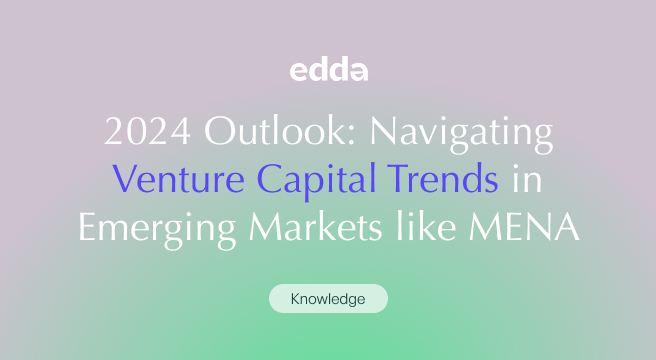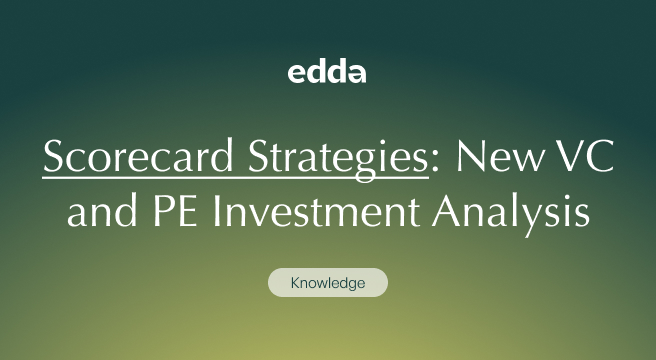As we approach 2024, the venture capital landscape in the MENA region stands to provide exciting new opportunities for investors.
According to MAGNiTT’s year-end reports, despite a global downturn, MENA showcased resilience with $2.6 billion raised across 477 deals in 2023. The anticipated growth in corporate venture capital vindicates a strategic shift in the region’s investment climate.
This evolving scenario highlights the importance of leveraging advanced investment tools to navigate the complexities of emerging markets. Sophisticated platforms like Edda’s venture capital deal flow software offer comprehensive solutions for deal flow management, portfolio oversight, and relationship building, essential for capitalizing on the nuanced opportunities and addressing the inherent challenges of the region.
Predictions for MENA Venture Capital in 2024
According to MAGNiTT’s comprehensive year-end reports on Venture Capital Investments in Emerging Markets (EVMs), the year 2023 was marked by significant developments in the MENA (Middle East and North Africa) venture capital landscape, and these developments have set the stage for what we can expect in 2024.
In 2023, EVMs as a whole witnessed an impressive $11.9 billion raised across 1.6 thousand deals. Specifically, the MENA region secured $2.6 billion through 477 deals. However, these numbers come against the backdrop of global economic challenges, including inflation and oil production curbs. As a result, MENA experienced a 23% year-over-year (YoY) funding retreat and a 34% YoY decline in closed transactions.
Despite these challenges, it’s worth noting that MENA outperformed the global VC slowdown average of 42%, as reported by CBInsights. This resilience is a testament to the region’s adaptability and potential for investment opportunities, even amid uncertain market conditions.
From these insights, MAGNiTT has used proprietary data and forecasting tools to formulate predictions for venture capital in the MENA region in 2024:
Four Quarters of Flat Non-Mega Deal Investment: One notable prediction is that excess investment is a thing of the past. We anticipate that quarterly investment trends will remain relatively flat across MENA throughout the year, excluding the mega deals. An uptick in the fourth quarter of 2024 is plausible if interest rates are cut in anticipation of a soft landing in the United States, as hinted by Jerome Powell.
Secondaries Boom: Liquidity remains one of the most significant challenges for the MENA ecosystem. Despite the region’s decade-long evolution, the number of exits has been relatively low. In the last five years, there have been 3,073 recorded investment rounds, raised by 2,829 startups across MENA, but fewer than 7.5% of them have successfully exited.
A notable prediction is the emergence of secondary offerings, providing much-needed liquidity to the market. This trend has been a hot topic for government discussions, aligning with efforts to create private-sector tech platforms to support employees, founders, and investors alike.
The Rise of Corporate Venture Capital (CVC): With corporations actively engaging in the MENA region, 2024 is expected to witness a surge in off-balance sheet investment mandates from large GCC (Gulf Cooperation Council) corporations, particularly in the Financial Services sector. This shift may elevate their share from the historical average of 13% to approximately 20%.
A Record Year of Exits: Despite challenges in 2023, predictions for a record year of exits gain stronger conviction in 2024. As the region eyes a potential Soft Landing and garners increased international interest, we anticipate the start of an IPO window for local listings, particularly in Saudi Arabia (KSA), and heightened consolidation driven by corporations and M&A activities.
The Continued Rise of KSA: Saudi Arabia’s growth trajectory remains uninterrupted, with five consecutive years of expansion in the venture capital space. All indications from the government, investment appetite, and startup migration point towards continued growth, solidifying KSA’s position as a regional leader, not only in terms of funding but also in transactions.
This growth will be closely monitored in comparison to more historically active Emerging Venture Markets, with Turkey leading in terms of transactions and Singapore leading in funding, as per our annual report.
Tapping into the Potential of MENA’s Emerging Markets
Expanding into emerging markets in the MENA region in 2024 offers businesses a plethora of opportunities. For instance, the rising middle-class population in MENA is driving increased consumer spending, making it an ideal market for consumer goods, e-commerce, and luxury brands. As an illustration, multinational corporations like Amazon and luxury fashion brands have made strategic inroads into these markets, tapping into the growing demand.
Furthermore, MENA’s commitment to economic diversification, exemplified by Saudi Arabia’s Vision 2030 and the UAE’s National Agenda, creates conducive conditions for investments in sectors such as renewable energy and infrastructure development. Notable examples include the UAE’s investments in solar power projects and Saudi Arabia’s plans for the NEOM city, a futuristic metropolis powered by renewable energy.
Geographically, the MENA region’s strategic location as a bridge between Europe, Asia, and Africa positions it as a global trade hub. Businesses can leverage this geographical advantage for efficient regional and international operations. For instance, logistics companies like DP World and Maersk have expanded their presence in the region to capitalize on the bustling trade routes.
Governments in MENA often offer incentives to attract foreign investors, such as tax breaks and simplified regulatory frameworks. These incentives can significantly reduce the cost of doing business. Dubai’s Free Zones, for instance, have attracted numerous businesses with their favorable tax environment and business-friendly policies.
Moreover, the region’s abundance of natural resources, particularly in the energy sector, presents opportunities for collaboration and investment. International energy companies like TotalEnergies and ExxonMobil have established partnerships and invested in MENA’s oil and gas sector.
Cultural diversity in MENA provides an avenue for tailored products and services. For example, McDonald’s and Starbucks have adjusted their menus to cater to local tastes, showcasing the adaptability required to succeed in these markets.
However, successful expansion is not without obstacles, demanding a strategic approach that considers the nuances of each market within MENA, as cultural, regulatory, and economic dynamics can vary significantly between countries.
Thorough market research, local partnerships, and a deep understanding of consumer preferences are gold when it comes to effectively and fully capitalizing on the region’s remarkable potential for growth. Software venture capital are key for gathering these valuable insights.
Challenges in Emerging Markets and Their Impact on Investors
While investing in emerging markets offers tremendous growth potential, it comes with a set of unique challenges that stem from the dynamic nature of these economies. Understanding these challenges and their potential impact on investors is a must to guarantee informed investment decisions.
Political and Regulatory Uncertainty
Emerging markets often have unstable political environments and evolving regulatory frameworks. Frequent changes in government policies, legal systems, and taxation can create uncertainty for investors.
If not addressed properly, political and regulatory uncertainty can lead to unexpected costs or disruptions to business operations. Investors may face challenges in complying with changing regulations or navigating complex legal systems, impacting profitability and long-term sustainability.
For example, in 2014, Russia’s annexation of Crimea created significant political and regulatory uncertainty in the region. Foreign investors faced sanctions, changing legal frameworks, and geopolitical tensions. Many investments were affected, and some companies had to exit the market due to these challenges.
Currency Volatility
Currency exchange rate fluctuations are common in emerging markets, driven by various factors such as economic conditions, geopolitical events, and global market sentiment. Failure to manage currency volatility can significantly affect investment returns. Sudden devaluation or currency crises can erode the value of investments, leading to financial losses for investors and jeopardizing the viability of their ventures.
Argentina experienced a severe currency crisis in 2018, resulting in the devaluation of the Argentine peso. Foreign investors who did not hedge their currency risk faced substantial losses as the value of their investments plummeted due to the devaluation.
Geopolitical Risks
Emerging markets can be vulnerable to geopolitical tensions, which can disrupt investments and markets. Conflicts or trade disputes in neighboring regions may spill over and affect investments. Geopolitical risks can lead to market volatility and uncertainty. Investors may face sudden disruptions in supply chains, changes in trade policies, or even the expropriation of assets, resulting in financial losses and instability in their portfolios.
A good recent example of this is the US-China trade war, which began in 2018, and had global repercussions. Investors in emerging markets like Vietnam and Mexico, which were part of global supply chains, faced disruptions due to shifting trade policies and tariffs imposed by both countries.
Lack of Transparency
Information and data in emerging markets may be less transparent and reliable compared to developed markets. Investors may struggle to access accurate financial data, making due diligence challenging. Insufficient transparency can lead to misinformed investment decisions. Without reliable data, investors may overlook critical risks or underestimate market conditions, potentially resulting in poor performance and missed opportunities.
Cae in point: the Wirecard scandal exposed the challenges of investing in emerging markets with insufficient transparency. Wirecard, a German fintech company, faced accounting irregularities in its Asian operations. Investors suffered significant losses as the true financial situation was not accurately reported.
Infrastructure & Logistics
Inadequate infrastructure, including transportation and communication networks, can hinder business operations and affect the supply chain. Not being properly prepared for infrastructure challenges can lead to increased costs and logistical complexities. Delays and disruptions in the supply chain may impact the profitability of investments and hinder the scalability of businesses.
This is an all too familiar challenge for investors in Sub-Saharan Africa. Delays in transportation, power outages, and inadequate communication networks can impact supply chains and raise operational costs for businesses.
Cultural and Language Barriers
Differences in culture and language can complicate negotiations, partnerships, and communication with local businesses and authorities. Misunderstandings or misinterpretations can potentially result in contract disputes, strained relationships, and operational inefficiencies. Failure to bridge these gaps can hinder the success of investments.
Walmart’s entry into the Chinese market in 1996 faced challenges related to cultural and language barriers. The company had to adapt its business model and product offerings to cater to local preferences.
Economic Instability
Emerging markets may experience economic instability due to factors such as inflation, high unemployment rates, or economic crises. This can disrupt investment decisions and returns. Unforeseen economic downturns may lead to reduced consumer spending, lower demand for products or services, and financial losses for investors.
Venezuela has been facing ongoing economic instability, including hyperinflation and political turmoil. Investors who had assets in the country saw their investments lose value rapidly, and some struggled to repatriate funds.
Legal Protections
Investors may face challenges related to the enforcement of contracts and protection of intellectual property rights in emerging markets. Inadequate legal protections can expose investors to legal risks. Disputes may arise, resulting in financial losses or the inability to safeguard intellectual property, compromising the value of investments.
Investors in India have faced challenges related to the enforcement of intellectual property rights. Disputes over patents and trademarks have led to legal battles, impacting the value of investments.
Lack of Local Knowledge
Understanding local market dynamics, consumer behavior, and competition can be a significant challenge for foreign investors without sufficient local knowledge. A lack of local insight can lead to poor strategic decisions, missed opportunities, and suboptimal market positioning. Investors may fail to adapt to local preferences and trends, affecting the success of their investments.
Uber faced challenges in Southeast Asia due to a lack of local knowledge. The company had to adapt its services and pricing strategies to suit local preferences, ultimately leading to its acquisition by Grab in the region.
Environmental and Social Factors
Evolving sustainability standards and expectations require investors to navigate complex environmental and social responsibilities. Neglecting environmental and social factors can result in reputational damage, regulatory scrutiny, and reduced market access. Investors may face public backlash or legal consequences if they do not align with evolving sustainability requirements.
Oil companies operating in the Niger Delta have faced environmental and social responsibility issues. Environmental damage and social unrest have led to reputational damage and regulatory scrutiny for these companies.
Leveraging VC Softwares in Emerging Markets
As investors eye the opportunities presented by emerging markets in 2024, the need for sophisticated VC software becomes obvious. Edda’s venture capital management software offers a vital solution, providing the analytical depth and operational agility required to address the unique challenges of emerging economies.
Advanced CRM: Edda’s venture capital CRM is designed to manage and analyze extensive networks and relationships crucial for success in diverse markets, enabling investors to maintain strong connections and leverage local insights.
Deal Flow Management: Edda’s deal flow management software provides a transparent and efficient overview of investment opportunities, facilitating the identification and evaluation of viable ventures in rapidly changing market conditions.
Portfolio Management: With Edda, investors can closely monitor the performance of their investments across various sectors and geographies, gaining real-time insights that are critical for adapting strategies in volatile environments.
Analytical Tools & Insights: Edda’s venture capital reporting software offers data-driven insights and analytics, allowing investors to understand market trends, assess risks, and make informed decisions that align with the dynamic nature of emerging economies.
Collaboration & Sharing: The platform enhances collaboration among investment teams and external partners, ensuring seamless communication and information sharing, which is vital for coordinating efforts in fragmented markets.
For those ready to tap into the high-growth potential of emerging markets, Edda serves as a key enabler, providing the clarity and control necessary to manage the inherent volatility and uncertainty.
Embrace Edda as your strategic partner in 2024 and transform your approach to emerging market investments with precision and confidence. Explore Edda’s capabilities and set the course for a successful investment journey in these vibrant economies.









